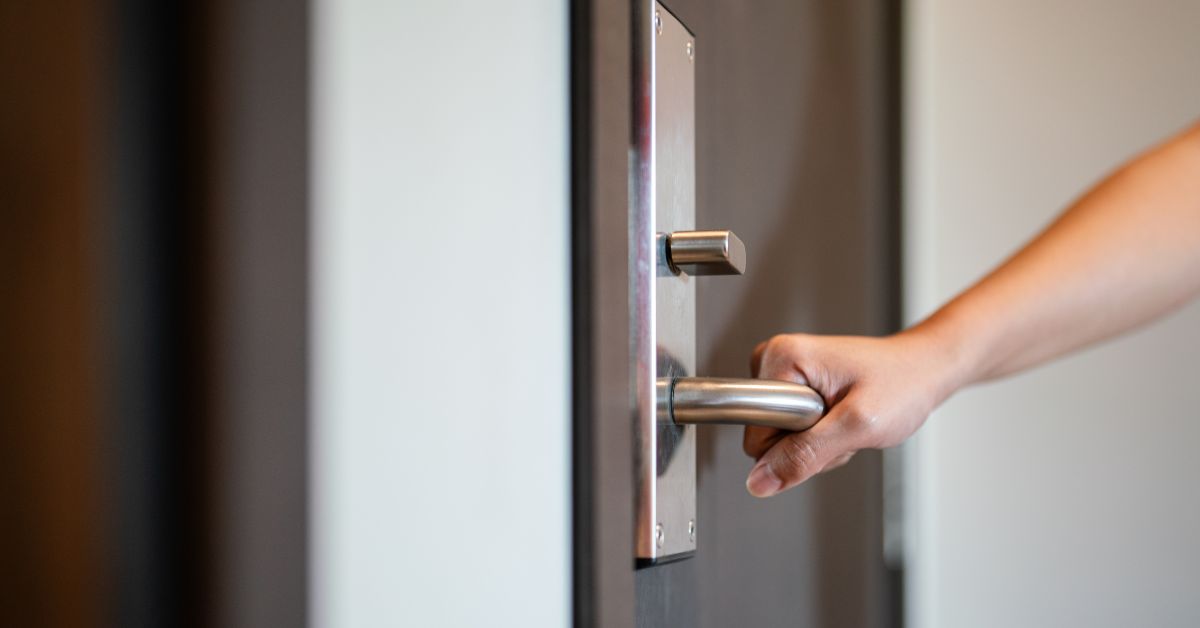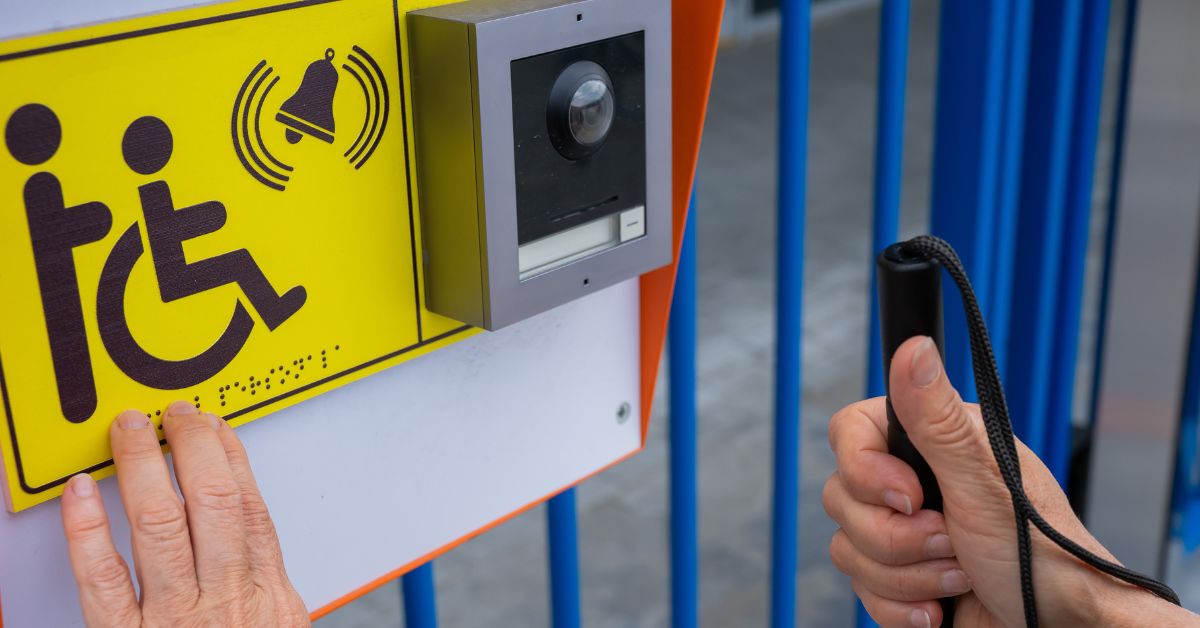6 Ways To Ensure Your Commercial Door Is Accessible

1. Check the Door Width
A narrow doorway can immediately deter people who use wheelchairs, crutches, or other mobility aids. A wide opening allows smoother entry that everyone can use. To meet accessibility standards, the ADA requires a minimum clear opening of 32 inches when a door is open at a 90-degree angle.
This measurement provides ample room for people using mobility aids to move through the doorway without struggling. For double doors, at least one side must meet this specification for compliance. Verifying your door meets these requirements is a straightforward way to evaluate if your entryway aligns with accessibility standards.
Strategies To Widen Narrow Doors
If your doors don’t meet the required minimum width, making upgrades can resolve the issue. Replace the door with one that fits a broader frame or modify the current structure.
Pocket doors or sliding doors can save room and provide accessibility in areas where traditional swinging doors don’t work. Another option includes removing outdated doorstops or trimming down obstructions that restrict the door’s clear opening.
2. Choose Accessible Door Handles
Round knobs can be difficult for people with limited hand strength, grip issues, or arthritis to operate. Round knobs require fine motor skills, unintentionally creating a barrier even for visitors carrying bags or pushing carts. Fortunately, lever handles are inclusive alternatives. Levers require minimal effort to use, as users push them downward to operate the door.
They’re also useful for people holding bulky items. For instance, an office building with lever handles makes entry manageable for an employee balancing work tools or a coffee cup.
Ideal Handle Placement
The placement of door handles determines how easily people can reach and use them. When you install handles too high or too low, they can become a source of frustration. ADA guidelines recommend that handles sit no higher than 48 inches from the floor and within reach for most users. This thoughtful placement benefits people who are short or seated.
Material and Design Tips
The materials you choose for your door handles also impact accessibility. Smooth finishes with non-slip properties, such as brushed metal or coated finishes, provide a comfortable grip. Avoid designs with sharp edges or intricate patterns that could make the handle difficult to maneuver. Overall, a sleek lever with a soft curve is functional and professional-looking.

3. Install Automatic Door Systems
Automatic doors provide effortless entry and exit for people using wheelchairs, canes, or crutches or carrying heavy items. Automatic doors also support the flow of foot traffic in retail stores, healthcare facilities, shopping centers, or airports. Automatic doors come in various styles to suit different commercial needs. Motion-activated systems use sensors to detect an approaching person and open automatically.
Push-button actuators, at wheelchair-accessible heights of 34–48 inches above the ground, allow users to open the door with a button. Sliding doors, swinging doors, or revolving doors with automation technology provide flexible options. For example, a library with limited doorway space might benefit from sliding automatic doors for unobstructed entry.
4. Utilize Appropriate Commercial Door Closers
Utilizing appropriate door closers is another way to ensure your commercial door is accessible. The door closers prevent slamming or drifting, helping people navigate entrances. A closer also eliminates challenges for individuals who may struggle to push or pull heavy doors.
Adjustable closers allow fine-tuning of parameters such as swing speed, latch force, and backcheck. For example, a business owner might adjust the closer at the main entrance to reduce the force needed to push the door. This change complies with ADA guidelines while improving the experience for all users.
Lightweight door closers are particularly useful for improving accessibility. These closers require minimal effort to operate, allowing easier entry for everyone. They are great in senior centers or public libraries, where visitors may rely on assistive devices.
Safety and Durability Benefits
Door closers enhance safety by preventing doors from slamming shut, which could injure someone’s fingers or create a tripping hazard if a door suddenly swings back. They also keep doors propped securely in windy conditions, preventing unintentional closing that might block or startle a user.
A thoughtfully selected closer balances accessibility with durability. For instance, a shopping mall entrance might have hydraulic closers with adjustable tension so that the doors close gently.
5. Add Braille and Signage for Inclusivity
Clear and consistent signage ensures people with visual impairments can understand and use routes, exits, and entryways. Signage that lacks visibility or tactile features creates confusion, and visitors may not feel confident in your space.
Adding Braille to signage supports users with low to no vision, as they can locate entrances, exits, restrooms, or emergency exits. Placement of Braille signage matters—mount signs where people can easily touch them, generally at 48 inches above the ground on the pull side of the door.
Beyond tactile features, signs need clear visual displays. High-contrast signs, with bold white letters on dark-colored backgrounds, make text stand out and remain visible at a distance.
Specialized Door Signage Examples
Signage can serve multiple purposes, from general navigation to specific instructions. For example, placing “Pull to Open” or “Push to Open” signs with Braille on glass doors helps users prepare for the necessary movement.
Emergency exit doors should include clear directions, tactile features, and visual indicators, such as bright red background coloring, for immediate understanding.

6. Conduct Regular Maintenance and Upgrades
Even the best-designed doors lose functionality over time without regular maintenance. Hinges loosen, closers misalign, and automatic door systems wear down, creating obstacles for entry. Maintenance reflects care and commitment toward sustaining inclusivity, regardless of your industry or business size.
Regular Inspections help you identify wear, misalignment, or failure that could negatively affect users. Identifying and addressing these problems promptly ensures that everyone can continue to use the doors safely and comfortably.
Ultimately, accessibility evolves alongside user needs, so staying proactive keeps your commercial space compliant and inviting. Regular repairs and thoughtful upgrades reassure your staff and visitors that their experiences matter.

Author
Greg Richard
Chief Technical Officer and Founding Member of DoorHub.com